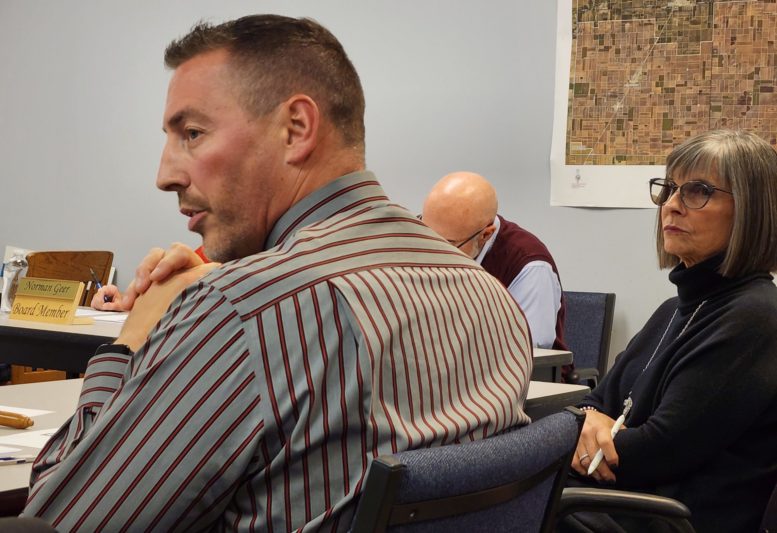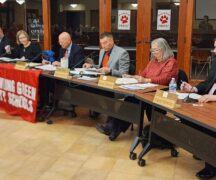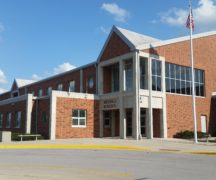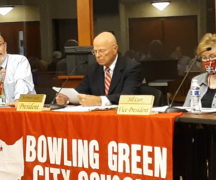By JAN LARSON McLAUGHLIN
BG Independent News
After taking another licking at the polls in November, Bowling Green Board of Education members on Thursday discussed some of the tough lessons they learned.
The community wants the district to seek state funding. Voters want specific plans for the buildings they are being asked to support. And the district should stop trying to placate rural voters, since they overwhelmingly don’t support school issues.
During Thursday’s board workshop, the members remained united in their quest for new school buildings – and in agreement to try for another levy in November for a new high school. Board members are hoping for more support from the city this time around, since the proposed Abbott plant on the north edge of Bowling Green is expected to bring 450 jobs – and potentially many new families to the city.
“We want to attract families from Abbott,” board member Tracy Hovest said. “So they don’t go to Perrysburg. So they don’t go to Findlay. So they stay here.”
Board member Ryan Myers agreed.
“They need to come to a community where the buildings are at least in decent shape. We don’t have that now,” Myers said.
But this time around, the board is approaching a levy armed with more knowledge.
Taxing decision
Rather than dividing the tax issue between property and income taxes – which benefit big landowners – the board will consider a straight property tax. While the district’s median household income dropped from $38,834 to $37,356 in the last five years according to the U.S. Census, the average home value increased from $156,600 to $178,700, said Treasurer Cathy Schuller.
A $70 million property tax issue would cost the owner of a home valued at $100,000 about $186 a year, Schuller said.
Unlike property taxes, income taxes are not collected from businesses – so more of the burden is shared with property taxes.
“We have to do what is most affordable for our constituents,” Hovest said.
While large farm landowners have promised in the past to support school issues if they are split between property and income taxes, that has not panned out.
“The city of Bowling Green supported the bond issues,” Superintendent Francis Scruci said. But the issues have consistently failed in all rural precincts. “They are single-handedly defeating it – and are proud of it.”
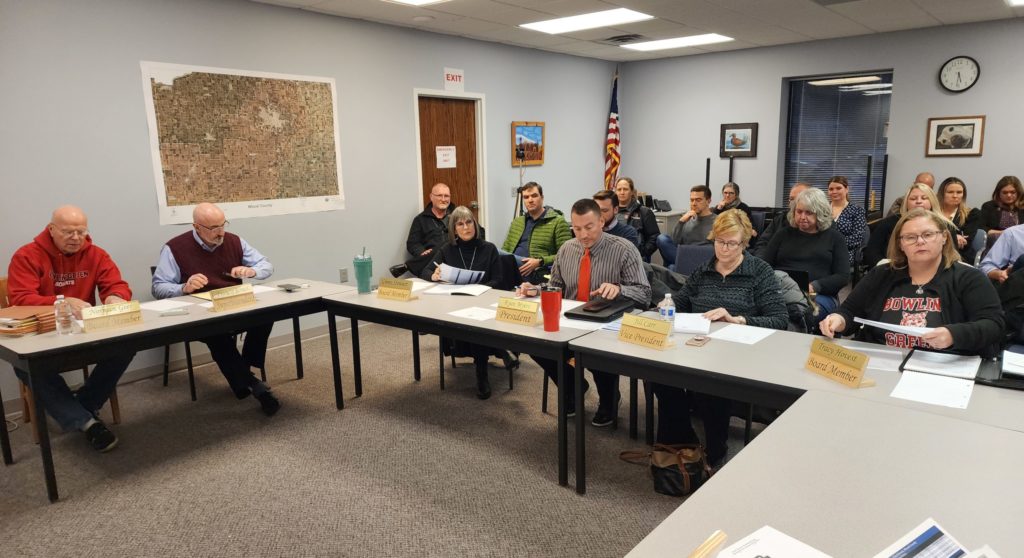
Timing is everything
The board does not want to delay another ballot issue. The filing deadline for the November ballot is Aug. 9.
“Clearly the bond issue that failed in November was heartbreaking,” Myers said of the last attempt to pass an issue for a new high school. Meanwhile, the building conditions are only continuing to decline, he said.
“We have multiple buildings that need addressed,” Myers said, noting the need for new elementaries as well. “I’m pretty gung ho to get something going. This is something that can’t wait.”
“I’m in favor of November as well,” board member Jill Carr said. “We have put so many different combinations before the voters,” to no avail.
“The high school needs to be the gem of the community. We’ve heard that over and over again,” Carr said.
Scruci pointed out the costs of aging buildings – with frozen pipes at the high school over the holiday break costing close to $50,000 to fix.
“We need to replace that building,” he said. “You can’t just slap a fresh coat of paint on these buildings and think it’s going to be better.”
Board member Ginny Stewart pointed out the money it takes to keep up with repairs that could be used toward new buildings.
“It’s served us well, but it’s time to have a new building,” board member Norm Geer said about the high school that was built in the 1960s. But Geer stressed that the district won’t stop with a new high school.
“We’re not forgetting about the elementaries at all,” he said.
The board is cognizant that the costs will only continue climbing.
Six years ago, the district tried for a $70 million levy to build a new high school and two elementaries. That $70 million will now pay for just a new high school.
“We owe it to the kids,” Geer said.
Take the money
The board got the message from the community that voters want the district to take state money for a building project – no matter how small the amount or how long the wait. Schuller has already reached out to the Ohio Facilities Construction Commission to get details on the Expedited Local Partnership Program.
The district would need to reapply, and submit details of the ballot issue to the OFCC by April, Schuller said.
Bowling Green School District is currently ranked 505th in the state for funding, so the funding won’t come anytime soon. The state share looks like 18% of the project now – but could end up closer to 13%.
The district would have to pay for a new building, then would be reimbursed that percentage in the future.
Can’t keep up with competition
Scruci said when new families tour Bowling Green High School they are impressed with the course offerings and teachers. But they usually end up enrolling their students elsewhere.
“It’s the quality of our buildings. We’re just not competing,” he said.
It’s time for the city to work with the schools to support new buildings, Stewart said.
“We need to work in concert with each other. Make Bowling Green a community people want to live in,” she said.
The conditions of the school buildings affect far more than the school district, Hovest said.
“It’s about our community. What do we want Bowling Green to be?” she said.
City officials must come to the realization that new schools are critical to the community as a whole, Stewart said.
“This is affecting everything,” she said, noting that the city seems to have reached a “collective hair on fire” moment. “I hope there’s a commitment. Until now, not enough people collectively cared.”
The city has to decide if it truly values education, Scruci said, adding that he is tired of being the scapegoat every time a levy fails.
“I’m going to walk away from here in November,” said Scruci, whose contract is up in July. “I hope it passes.”
But if it fails again, “who are they going to blame then?” he asked.
Other money sources
The school district is still waiting for a final ruling on how much the Rover Pipeline will pay in taxes to the district. “That pipeline appeal is still ongoing,” Schuller said. “It’s not a guarantee.”
The proposed Abbott Laboratories coming to Bowling Green has promised $265,826 annually for 15 years to the district as part of its tax abatement arrangement.
Board members asked about using those two chunks of funding to self-fund new construction. But Schuller said they fall far short of the $70 million estimated cost of a new high school.
“And both are not solid right now,” with the pipeline fighting its tax rates and Abbott still in the planning stages and the district not receiving any of that funding until 2025.
Communication issues
Board members expressed frustration about being criticized for not presenting enough new building details – or about decisions being made without public input. For each of the last three building issues on the ballot, focus groups were formed and community forums were held.
Few people attend the public meetings, Scruci said. And few took up the district’s invitation to tour the aging high school.
During the first couple building levies, a lot of time and money were spent to get information out about building plans.
“Still people said they didn’t know anything about it,” Scruci said.
The board seemed to reach a consensus that requests for qualifications should be sought from architectural firms interested in drawing up specific plans for a new high school.
“People do want to know what the vision is,” Hovest said.
Myers suggested that the district make virtual walk-throughs available to voters, and engage students to talk about features of a new building.
“I, for one, am not interested in putting together another focus group,” Myers said.
Stewart agreed that would just “drag the process out. We’ve offered participation to everyone in the community. Let’s move forward.”
Stewart suggested that the architectural firm also be asked to create a vision of what new elementaries could look like in the community.
“This could give people an idea what the future of Bowling Green could look like,” she said.

